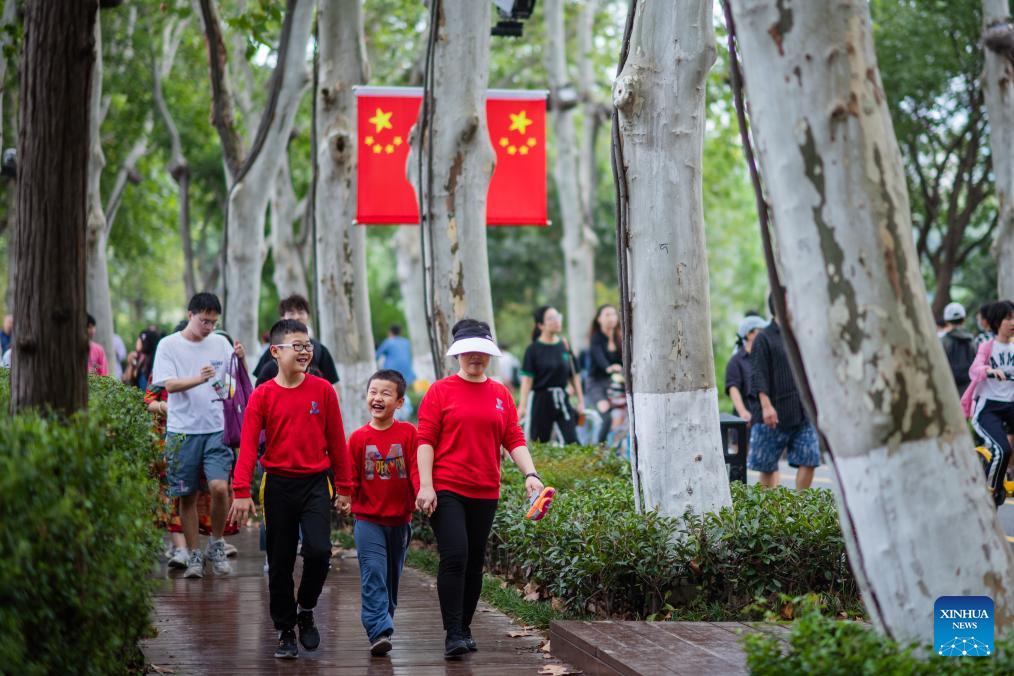
People visit Donghu Lake scenic spot in Wuhan, central China's Hubei Province, Oct. 1, 2023. People across the country enjoy themselves in various way on the first day of the National Day holiday. (Xinhua/Wu Zhizun)
Traveling to see cultural heritages in the western desert, watching talk shows, and playing sports, Chinese are enjoying the longest "golden-week" holiday in diverse and exciting ways.
The National Day holiday, dubbed "golden week" by the Chinese, normally runs for seven days, but this year it is linked with the traditional Mid-Autumn Festival and extended to eight days, lasting from Sept. 29 to Oct. 6. A longer holiday fuels people's enthusiasm to travel and enables them to engage in various cultural activities.
More than 395 million trips to tourist sites were made in the first three days of the holiday, up 75.8 percent year-on-year, and the total revenue of the tourism sector increased by 125.3 percent to 342.24 billion yuan (47.67 billion U.S. dollars) in the three days, according to the Ministry of Culture and Tourism.
Popular tourist destinations are flooded by visitors. Leading tourist sites in Beijing received 6.83 million tourists in the first three days of the holiday, up 60.6 percent year-on-year and up 31.8 percent over that of 2019.
Dunhuang, in northwest China's Gansu Province, home to a UNESCO World Heritage site, recorded 28,000 visitors on the first day of the holiday, an increase of 58.45 percent over that of 2019.
The surge of visitors not only results from people's eagerness to travel after the COVID-19 pandemic but also from continuous efforts from local tourism industries to explore unique cultural and historical attractions.
During the eight-day holiday, Kuanzhai Alley, a traditional neighborhood in the southwestern Chinese city of Chengdu, recreated night bazaars of Tang (618-907) and Song dynasties (960-1279).
Walking along the winding alleys, visitors bump shoulders with people dressed up as ancient figures and experience shopping in ancient ways.
"It feels like time travel back to ancient days. My daughter is thrilled," said a visitor surnamed Yang from southeast China's Fujian Province. Her six-year-old daughter was also wearing a traditional dress.
The "red" tourist destinations, which featured the country's revolutionary history, also draw visitors driven by their love for the nation.
The number of visitors to the Liupanshan Red Army Long March scenic area in Guyuan of northwest China's Ningxia Hui Autonomous Region has grown year by year, and it expects to welcome nearly 20,000 tourists during the holiday this year, said Lu Xuezhou, deputy general manager of the site.
"On Oct. 1, we organized various celebrations for visitors, including sunrise viewings, national anthem renditions, and national flag-raising ceremonies," Lu said. "There will also be a red art performance to celebrate the 74th anniversary of the founding of the People's Republic of China, and tourists can walk along a 'Red Army path' to trace the history of the Long March and learn from the Long March spirit."
Those who do not travel far during the holiday are not idle at home. They went to cinemas, pushing the national box office to exceed 2 billion yuan.
They watched talk shows, plays, and circus shows. The 148 theaters across Beijing presented 828 performances and attracted 227,000 audiences in the first three days of the holiday, up 269 percent and 168.3 percent, respectively, from those of 2019.
They did exercises. "All our courts have been booked for all opening hours during the eight-day holiday," said Wang Peng, a manager of a badminton hall in Yiyang City of central China's Hunan Province. The badminton hall has 12 courts and opens from 9 a.m. to 10 p.m.
Hangzhou, capital city of east China's Zhejiang Province, is hosting the Asian Games and thus drawing many tourists aiming for both its picturesque West Lake and sports games.
The main stadium of the Games received more than 40,000 audiences on each of the first two days of the holiday.
Mr. Shao, from Qingdao in east China's Shandong Province, took his parents to watch programs of track and field and badminton. "We go sightseeing and watch sports games while spending quality time with the family, a good holiday plan that achieves multiple purposes at one stroke," he said.